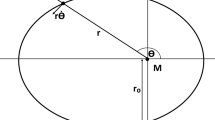Abstract
Distinguishing mechanistic components from mere causally relevant background conditions remains a difficulty for mechanistic accounts of explanation. By distinguishing resources from mechanical parts, I argue that we can more effectively draw this boundary. Further, the distinction makes obvious that there are distinctive resource explanations which are not captured by a traditional part-based mechanistic account. While this suggests a straightforward extension of the mechanistic model, I argue that incorporating resources and resource explanations requires moving beyond the purely local account of levels that some mechanists advocate.
Similar content being viewed by others
Notes
Thanks to an anonymous reviewer for suggesting the example.
Indeed, for disciplines without a clear agent-patient distinction, the two carvings might not get much purchase anywhere. Simple physical explanations are an obvious example: in the world of atoms and void, things simply happen, without actor or acted upon. This may be why the mechanistic style of explanation seems less useful in the case of basic physics. This is not something special about physics per se though: more complex physical explanations might reproduce the agent-patient structure. Consider explanations of supernovas. The star uses its fuel, and once it is forced to rely on inferior resources for stellar combustion it goes nova. Having reconstructed the agent-patient structure, it is also natural to talk about the mechanisms of stellar evolution. Conversely, there are systems that resist an easy agent-patient dichotomy because they appear to have features of both at once. The most obvious of these are what Bechtel calls active mechanisms (2008, Ch8). These include the mechanisms involved in autocatalytic loops, homeostatic processes, and other feedback cycles. Key to mechanisms with feedback is the possibility of a mechanism altering its own operation—that is, acting at the same time as agent and patient. Active mechanisms are, as Bechtel argues, key to understanding many living processes; they’re also arguably more important for understanding many neural processes (Bechtel 2008).
See also Craver and Darden (2013, 88) and Bechtel and Richardson (2010, xix). A local sense of level arguably predates the mechanists. Marr’s (1982) famous tripartite division of levels is drawn relative to a particular explanatory task; the lower levels are investigated in the context of sorting out the details of the computational level. Similarly, homuncular functionalism is concerned with functional decomposition relative to a starting capacity (Lycan 1990).
References
Bechtel W (2008) Mental mechanisms: philosophical perspectives on cognitive neuroscience. Taylor & Francis, New York
Bechtel W, Mundale J (1999) Multiple realizability revisited: linking cognitive and neural states. Philos Sci 66:175–207
Bechtel W, Richardson R (2010) Discovering complexity: decomposition and localization as strategies in scientific research. MIT Press, Cambridge
Botvinick MM, Cohen JD (2014) The computational and neural basis of cognitive control: charted territory and new frontiers. Cogn Sci 38(6):1249–1285
Campbell J (2007) An interventionist approach to causation in psychology. In: Gopnik A, Schulz L (eds) Causal learning: psychology, philosophy and computation. Oxford University Press, Oxford, pp 58–66
Campbell J (2010) II—control variables and mental causation. Proc Aristot Soc 110:15–30
Caramazza A (1986) On drawing inferences about the structure of normal cognitive systems from the analysis of patterns of impaired performance: the case for single-patient studies. Brain Cogn 5(1):41–66
Craver C (2007) Explaining the brain. Oxford University Press, New York
Craver CF, Darden L (2013) In search of mechanisms: discoveries across the life sciences. University of Chicago Press, Chicago
Cummins R (1975) Functional analysis. J Philos LXXI I(20):741–765
Cummins R (1983) The nature of psychological explanation. MIT Press, Cambridge
Duntemann J (2011) Assembly language step-by-step: programming with Linux. Wiley, New York
Haugeland J (1998) Mind embodied and embedded. Having thought: essays in the metaphysics of mind. Harvard University Press, Cambridge, pp 207–240
Klein C (2017) Brain regions as difference-makers. Philos Psychol 30(1–2):1–20
Lycan W (1990) The continuity of levels of nature. In: Mind and cognition: a reader. Basil Blackwell, Cambridge, pp 77–96
Marr D (1982) Vision: a computational investigation into the human representation and processing of visual information. WH Freeman, New York
Menzies P (2007) Causation in context. In: Corry R, Price H (eds) Causation, physics, and the constitution of reality: Russell’s republic revisited. Oxford University Press, Oxford, pp 191–223
Messier C (2004) Glucose improvement of memory: a review. Eur J Pharmacol 490(1):33–57
Newman LA, Korol DL, Gold PE (2011) Lactate produced by glycogenolysis in astrocytes regulates memory processing. PloS ONE 6(12):1–11
Oppenheim P, Putnam H (1958) Unity of science as a working hypothesis. Minn Stud Philos Sci 2:3–36
Potochnik A (2010) Levels of explanation reconceived. Philos Sci 77(1):59–72
Shallice T (1988) From neuropsychology to mental structure. Cambridge University Press, Cambridge
Shapiro L (2005) The mind incarnate. MIT Press, Cambridge
Simon HA (1996) The sciences of the artificial, 3rd edn. MIT Press, Cambridge
Waters CK (2007) Causes that make a difference. J Philos 104(11):551–579
Woodward J (2010) Causation in biology: stability, specificity, and the choice of levels of explanation. Biol Philos 25(3):287–318
Acknowledgements
Thanks to Peter Clutton, Liz Irvine, Annelli Janssen, Meg Ivory, Chris Lean, Marco Viola, Elizabeth Schier, and participants at the 2014 Cognitive Science Kioloa workshop for helpful comments on earlier drafts. Thanks to Yellow Car, and indirectly to Karen Bennett, for inspiring many of the automotive examples. This research was supported by Australian Research Council Grant FT140100422.
Author information
Authors and Affiliations
Corresponding author
Rights and permissions
About this article
Cite this article
Klein, C. Mechanisms, resources, and background conditions. Biol Philos 33, 36 (2018). https://doi.org/10.1007/s10539-018-9646-y
Received:
Accepted:
Published:
DOI: https://doi.org/10.1007/s10539-018-9646-y



